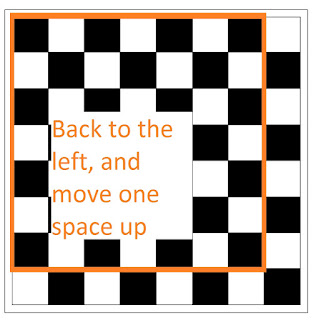First, count how many 1-by-1 squares there are. This is easy as there are 8x8 small squares, or 64.
Next, I would count the 2-by-2 squares. This is tricky, as they will all overlap. I count 7x7, or 49, of these squares (since you count from right to left, but omit the last one, and the same from top to bottom).
(Using my counting method, there would be 6 2-by-2 squares,
as denoted by the 6 colours, in this section of the board.
I explain my method at the end.)
For 4-by-4 I get 5x5, or 25.
For 5-by-5 I get 4x4, or 16.
For 6-by-6 I get 3x3, or 9.
For 7-by-7 I get 2x2, or 4.
For 8-by-8 I get 1x1, or 1.
Here is my diagram for 7-by-7, so that you understand the method and can extrapolate for the other numbers:
As I was solving this question, my thoughts went from, "let's count how many squares there are," to, "there are too many squares to count, I need to find a pattern". From there I first decided to find how many different squares there were and then count each type. My thought process did not change to much other than the one shift, as my method worked and seemed effective enough for the small size of the problem. Afterwards I was trying to think of new methods and how other people might approach the question.
I think the best way to extend this problem would be to give a different shape (such as a triangle or circle) with a checkerboard pattern in it and to count how many complete squares are contained within it. I think this would be an interesting extension because you would need a new method for this approach (as opposed to giving them a larger square or rectangle). Another method would be to paint the smaller squares in a pattern of colours and ask them to find how many squares there are that don't contain a certain colour.






Very nice, Jacob! Love the beautiful graphics you've made. Now how might you extend this if you were using it as a class activity?
ReplyDelete